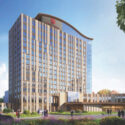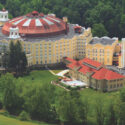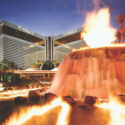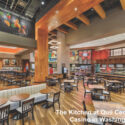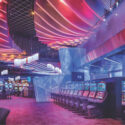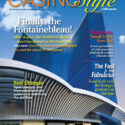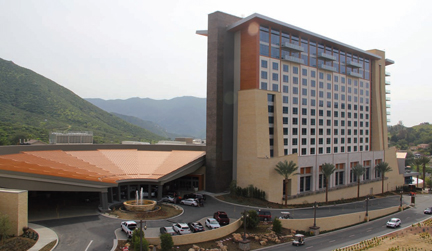
What an ascent.
Cody Martinez chuckles, recalling the childhood root beer float memory.
It sprang from the concession stand of the bingo hall, where he’d grown up on the Sycuan reservation near San Diego. The drink held a dreamy enticement, the barometer of scoring big.
“The bingo hall was right in my backyard,” he indicates. “Sometimes after school when the bus had dropped me off, I was able to get one of those root beer floats. That was a unique thrill for me. You know, we have a strong sense of community here, and I’d say there are at least two dozen employees still around who remember me during that time. They have seen me grow up from being a school-age kid.”
And now look. Three decades later, the boy became Chairman Martinez, 38, and head of the Sycuan Band of the Kumeyaay Nation. Early this year, the group he leads unveiled a major casino expansion on the land where the bingo hall once stood as its cornerstone.
There is 500,000 square feet of additional property space, 60,000 of it earmarked for gaming. There’s an award-winning 12-story hotel, a pool, cabanas and night life.
The innovative project cost roughly $226 million, transformed the gaming identity of the tribe and features, among other amenities, several new restaurants.
That’s a lot of root beer floats.
Bold Strides
The expansion marked Sycuan as a high-profile player in population-rich Southern California. Targeting local and regional markets, this move reflects recent trends of bringing Las Vegas to California, thus retaining a lucrative patron base via glamour-laden staycations.
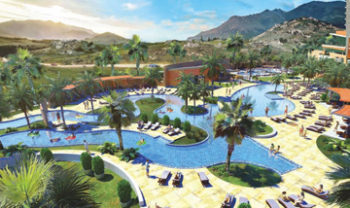
The extensive pool area, complete with a lazy river, has delighted guests since the Sycuan grand opening
The tribe went full scale. It employed HBG Design, the renowned architecture and design company based in Memphis with an office in San Diego and a coveted niche in tribal-gaming circles.
The rollout changed the pace of operations, comparable to a major sport in which the speed of play intensifies. Raised stakes and enhanced stature mark this transition to a major stage.
The new era produced several gaming puzzle pieces.
“When you get into the region with Pechanga and other major resorts, we don’t have the idea that we will directly compete with them but we can be the premier gaming resort in San Diego County,” Martinez says. “We are an all-inclusive gaming resort, and will give you an excellent reason to drive two or three hours and stay with us.
“We are thrilled with the expansion and we will continue to strive to be aggressive,” he adds, assessing the property’s first six months of post-expansion performance. “We are learning new things as we grow into being a destination resort, a switch from being a hometown gaming house.”
By renovation standards, this was massive. An amount exceeding $100 million is considered a decent-sized venture. This total could actually build a facility from scratch.
The large operation breeds a delicate juggling act. On the financial side, higher expenses accompany more profits. In the operations realm, bells and whistles share space with peace and quiet. Slot-playing boomers blend with app-driven millennials.
“We are trying to find the sweet spot,” Martinez indicates.
That sweet spot, denoting balance, is worthwhile. The restaurants, pool and upscale hotel lure an amenity-driven demographic, while the property seeks to retain core clientele.
“We want to attract gamers who might normally not come, and they may want to bring their kids,” Martinez says. “At the same time, you don’t want to alienate the traditional customers. We don’t want the gaming floor turned into a playground.”
Martinez knows that the 55-and-over crowd remains “the base of the cake,” but that slot revenues can’t be counted on as the main driver forever.
There looks to be room for everything. The 12-story hotel was well received, obtaining a rare AAA Four-Diamond Inspector rating awarded to less than 7 percent of hotels inspected by AAA. The balconies with views overlooking the mountains, along with the pools, cabanas and swim-up bars, suggest non-gaming affluence. Yet there are also many opportunities to play, grab food quickly and not miss a beat.
How It Was Built
Sycuan tapped the services of a trusted partner to orchestrate the vision. HBG Design was lead resort planner, designer and architect-of-record for the Sycuan Casino Resort expansion project.
“We began our relationship with Sycuan in 2008, when the firm was hired for the large-scale renovation of the Sycuan Casino,” says Dike Bacon, HBG Design principal.
“The casino renovation completed in 2012, and that project set the stage for Sycuan’s recent expansion and current success,” he adds.
This one was substantial. Bacon says the project included the 12-story, 300-room, 57-suite hotel tower adjacent to Sycuan’s existing casino.
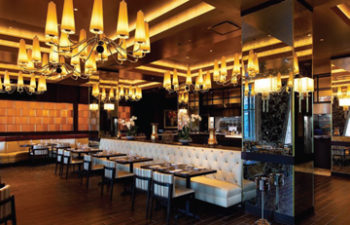
The Bull & Bear is just one of more than a dozen restaurants and lounges in the new Sycuan resort
Highlights include a new four-acre, palm-tree-lined pool complex with a resort-style adult pool experience including cabanas, an open pool deck along with a bar and grill and a swim-up bar, gardens, a lazy river, and a dedicated family pool. The new gaming space added 350 gaming machines. Innovative dining, retail and entertainment venues emerged. The sports bar has been repositioned into a brew house focused on local craft beer. Meeting and conference space, a full-service spa and fitness center are also part of the expansion.
Capitalizing on the idyllic climate of its mountain location in El Cajon, Sycuan began billing itself as a staycation getaway to local and regional guests after the renovation completed.
“While gaming remains central to its operation, the Sycuan expansion has opened an array of revenue-generating opportunities for Sycuan and helped fulfill a need for more distinct guest experiences—such as poolside concert events, meetings and conferences, and chic indoor/outdoor dining with a sophisticated California vibe,” Bacon indicates.
Some of that vibe is the Elicit Edge Bar, a posh, edgy craft cocktail lounge, Bacon asserts. It is designed for late-night mingling.
Eastern design influences complement the fresh hand-rolled sushi and small-plate cuisine offerings. Low wooden ceiling planes and warm tones in carpeting and lighting create intimacy in the open space, which serves as lounge, cocktail bar and sushi bar.
Tribal culture mixed well with business sense on this venture, according to HBG experts in the interior and exterior sectors.
“The strength of the planning and design scheme lies in its ability to create a new image and front door for the property,” says Shawn Hobbs, HBG Design principal and the lead architectural designer for the expansion project.
Western expansion adjacent to the existing casino allowed for maximum flexibility to meet future growth and development goals, he indicates.
From an exterior vantage point, the hotel tower is a welcoming beacon building energy and excitement for guests, Hobbs says. It rises monumentally, conveying the spirit and vibrancy of San Diego’s surrounding mountain valley.
“The hotel’s architectural form is derived from aspects of Sycuan culture and history and contextual influences found in the Southern California region,” he adds. “A classic butterfly roof caps the hotel tower, reminiscent of the outstretched wingspan of the red-tailed hawk, a symbolically significant element in Sycuan culture.”
The new porte cochere anchors the central area between the existing casino and new hotel tower expansion, and continues the celebration of the natural environment in form and different stone and metal material. The porte cochere structure derives its circular, staggered form from the tail feathers of the red-tailed hawk, fashioned by a copper standing seam roof and wood-look aluminum finishes in rich medium cherry tone.
Inside Magic
Rob Jurbergs, HBG Principal and interior architect of this project, says Sycuan officials utilized sophisticated planning.
“Even in the elegant interior hotel lobby space, the dramatic two-story video wall behind the hotel registration desk brings the outdoors in by providing opportunities for changing visual content including vivid imagery of regional landscapes,” Jurbergs says.
Guests are welcomed through the central “hub” porte cochere, which provides them with a convenient connection to all areas of the property.
Radiating from the entry hub are the new hotel, new casino, and entertainment venues, as well as the existing casino and parking garage.
Jurbergs says Sycuan officials had a long-term view of this expansion.
“During early design visualization workshops with Sycuan, ‘timeless design,’ ‘elegant,’ ‘sophisticated,’ ‘neutral,’ ‘natural,’ ‘warm’ and ‘design that is not too trendy’ became the frequent words and common visual themes selected by stakeholders,” he says. “Trendy designs become dated quickly and need renovations more often. Sycuan is mindful of costs, so durability and maintenance were huge concerns. Sycuan worked to make strategic long-term investment decisions, so the property did not require major renovations year over year to update or replace design elements as they grew stale.”
This project will look fresh for a long time.
An Academic Perspective
Dr. Kate Spilde provides a scholarly and integrated overview to the expansion. The San Diego State University professor is an endowed chair of the Sycuan Institute on Tribal Gaming, teaching and managing the nation’s first four-year degree program in tribal casino operations management.
Much of her work focuses on providing support for tribal governments to direct their casino gaming revenues toward nation building or rebuilding efforts. Spilde has addressed audiences around the world on tribal matters, and finds significance in the Sycuan Tribe growth.
Spilde cites the expansion’s dual role of luring visitors and attracting customers in the facility’s backyard. The major California population base is a good target for patrons who want to enjoy accommodations and amenities far better than they’d have in their own homes.
“Tribal governments and operators in Southern California have now been in the business for 30 years and know this market very well,” Spilde says. “Many of the properties in Southern California are adding or expanding their hotel offerings to keep guests on property longer, in a luxury environment, and ideally retaining those players who used to drive to Las Vegas.
“There are several impressive integrated resorts in Southern California,” Spilde adds. “Sycuan joins Viejas, Pala, Rincon, San Pasqual, Pechanga and others who have invested heavily in the evolution of their properties from repeater-market properties to fully integrated resorts.”
This evolution represents the next phase in the casino life cycle where customer draw power evolves, Spilde asserts.
“With an integrated resort, amenity offerings increase in importance and gaming activities decrease,” she says. “These integrated resorts have incredible hotels, restaurants, golf courses, spas, convention and meetings spaces, entertainment spaces and many other opportunities for peak experiences.”
Spilde believes Sycuan’s evolution from repeater market to integrated resort, highlighted by the addition of the hotel, will extend the stay of day-trippers.
This expansion, in classic tribal efficiency, reflects prudent growth. Properties rarely speculate on the market future by spending exorbitant money to anticipate business.
“Tribal gaming expansion is very deliberate, in my experience,” Spilde indicates. “There are often limits set by tribal-state gaming compacts and, of course, by tribal concerns about balancing return on investment with return on community. What I mean by that is that tribal leaders tend to be more conservative than a business investor would be since they are very cognizant of investing tribal government and community dollars, not just business funds.
“The purpose of the tribal business, in this case the casino and resort, is to generate governmental revenue. There is really no option of failure as there would be for a traditional business where the company can go bankrupt, shut down or change its name. Tribal governments invest in gaming as a means to strengthen their governments, support their communities and invest in nation-building so they have a different framework for evaluating expansion investments and expansion returns.”
Spilde, who grew up in northern Minnesota, appreciates tribal dynamics in Southern California. It represents different means to a similar end.
“Tribal government gaming has been transformative there (Minnesota) in many important ways such as creating employment, strengthening tribal sovereignty and stimulating business diversification,” Spilde asserts. “There is strong return on community there, in my opinion. But the scope of gaming and the scale of the return is much more subtle than it is here in California, where the tribal communities have the means to make major investments both on and off the reservation. Both areas are great examples of tribal government gaming in action, but they are very different stories of tribal gaming success.”
In some areas, success is rooted in bingo halls. In others, it is in a sprawling resort.
Here, it is in both.




